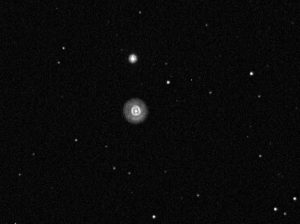
TRO Primer
It occurred to me recently my standard assumption is that everyone who looks at this site will understand what is posted. Not so! A friend of mine, an accomplished golf pro, wanted to go to a star party. So we went off to a party out in Kansas for the Astronomical Society of Kansas City. I was so proud of myself! Every time I talked to someone about an astronomy topic I turned to my friend and explained in great detail what we were talking about. On the hour drive home I asked him what he thought about the experience. His comment was “I really enjoyed looking through the telescopes but I had no idea what you were talking about!” It struck me that maybe this blog is a similar situation!
What is Temple Research Observatory? It is a home owned telescope and shelter dedicated to understanding more of the night sky. My observatory business card states “Understanding Through Research.” Some people just look through their telescopes, others like to play with the gadgets, however I like to learn things. Some of what you learn comes from trying to run an automated telescope (hundreds of pages of manuals!) and other information comes from the stars themselves. For example when TRO was established in 2009 it was common knowledge among many astronomers that White Dwarf Stars (old stars that have blown off their outer layers just leaving the hot core) do not vary in brightness. Some thought there could be a small variation due to star spots but that seems a bit absurd when you think about the structure of this kind of star. Turns out in my studies that many of these stars have a very slight but pronounced variation in brightness. In fact no one is quite sure why or how this happens. The star is so dense that the atoms are crammed together as close as they can get. A teaspoon of this matter would weigh around 5,000 pounds! How can a material that cannot be compressed any more pulsate, or change shape? There are several others studying these stars but lots of professionals went onto other objects because they believed that there was little to be learned, everyone knew that these stars didn’t vary! These are the kinds of issues the TRO addresses.
What telescopes do you have? The main scope at TRO is an 11″ telescope. The size usually refers to how large the mirror or lens is. Since light gathering is enhanced with bigger objectives (lens or mirror) then knowing the size is the most important feature of the scope. The light gather power of the objective is way more important than how much it magnifies! The larger the lens/mirror the more light that you gather. The telescope (Temple 28) was manufactured by Celestron and modified by my friend Tom Krajci. The stock telescope came with an aluminium tube. This is ok for looking through a telescope because you tend to focus when you go to a new object. But it is not so good when you use a camera and expect to observe all night. With the original tube, when the temperature drops 2-5 degrees the focus changes and will blur images taken with a camera. So the C11 CPC (model type) has a custom built carbon fiber tube. Carbon fibers don’t contract or expand with temperature changes so the temperature can change by 25 degrees and there will be no change in the image due to the tube.
The telescope itself is controlled remotely and robotically. Using a program called TeamViewer 10 I can control/program the scope with my computer indoors or even with my Kindle and phone! After programming the scope and making sure it is aligned, you start the control program and walk away. I do check on the scope from time to time using a computer, tablet or phone. In the morning after taking images all night I then download the images into my home office computer. These images are then processed (calibrated it is called) and run through software recording the variations in brightness.
I also have “The Beast” a 6″ refractor telescope, “Little Eye” a 60 mm telescope, “The Bargain Bucket” a 8″ homemade telescope and numerous other telescope setups. I have a Meade ETX that I use for looking at the sun with a homemade filter. At present I am working on making a Meade 8″ telescope into my travel scope. This is to facilitate imaging during the Monsoon in the southwest. You can pack it into your trunk and head off someplace where the skies are clear! Overall you can never have enough telescopes!
These are just a few of the things that Make TRO. Keep an eye out here on the TRO website for more discussion of how a home observatory works.
Paul